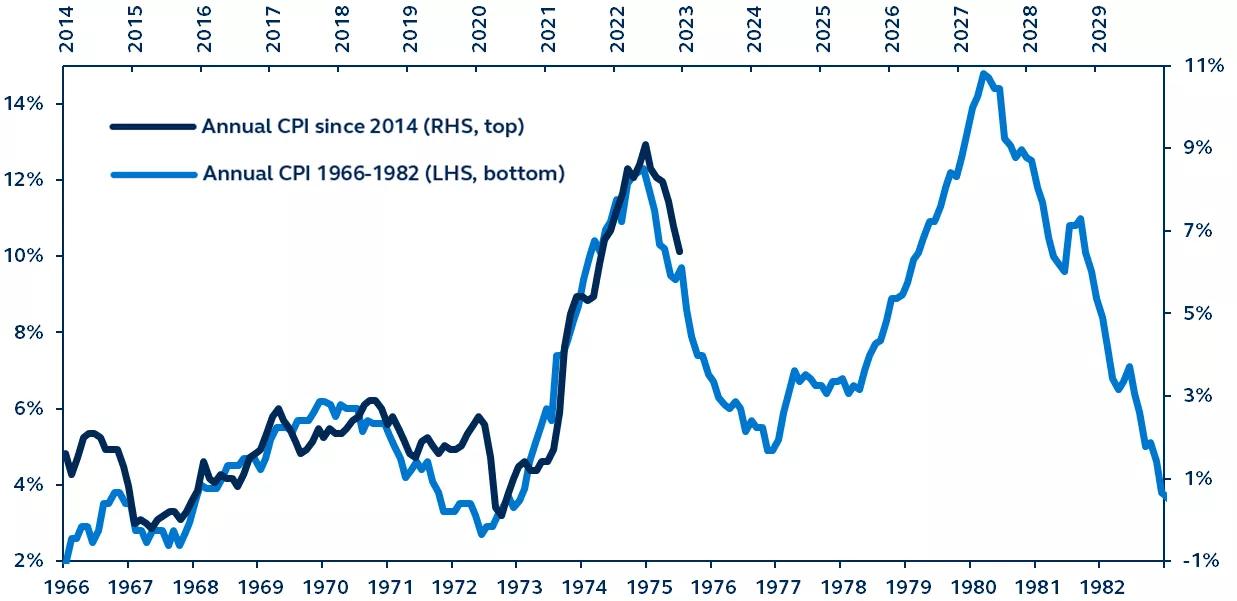The recent path of inflation bears a striking resemblance to that of the 1970s, the last time that the Federal Reserve faced such a significant battle with inflation. Then, the Fed prematurely began lowering interest rates, resulting in rapidly re-surging inflation. To avoid the same fate, today’s Fed must resist the temptation of loosening monetary policy too quickly.

Historical inflation comparison
Consumer Price Index (CPI)

Bureau of Labor Statistics, Bloomberg, Principal Asset Management. Data as of February 3, 2023.
With the Federal Reserve likely approaching the end of its tightening cycle and markets positioning for rate cuts later this year, the striking similarities between U.S. inflation developments today and those of the early 1970s could be instructive for the path forward.
- In the 1970s, inflation took an extended period to normalize. If inflation today continues to track the 1970s path, it could be mid-2024 before headline CPI reaches 2%.
- The Federal Reserve was anxious to ease monetary policy in the 1970s, cutting interest rates before price stability had been achieved. The result was a resurgence in price pressures. Today’s Fed has (hopefully) learned that lesson— lowering interest rates before it is confident that inflation is on a sustainable path back to 2% would threaten to undo all its hard work to date.
Inflation will not necessarily follow the exact path as the 1970s. While price pressures in both eras originated from a toxic mix of supply chain challenges, elevated oil prices, and excessively stimulative fiscal and monetary policy, the Fed’s framework today is more transparent and more focused on price stability. As a result, inflation expectations are better anchored, suggesting inflation should be quicker to normalize.
Even so, the experience of the 1970s has taught central bankers to take inflation risks very seriously. Investors take heed: Powell’s job is not yet done.
Investing involves risk, including possible loss of principal. Past performance is no guarantee of future results and should not be relied upon to make an investment decision.
The information presented has been derived from sources believed to be accurate; however, we do not independently verify or guarantee its accuracy or validity. Any reference to a specific investment or security does not constitute a recommendation to buy, sell, or hold such investment or security, and does not take account of any investor’s investment objectives or financial situation and should not be construed as specific investment advice, a recommendation, or be relied on in any way as a guarantee, promise, forecast or prediction of future events regarding an investment or the markets in general. The opinions and predictions expressed are subject to change without prior notice.
Principal Funds, Inc. is distributed by Principal Funds Distributor, Inc.
Principal Asset Management leads global asset management at Principal.®
For Public Distribution in the U.S. For Institutional, Professional, Qualified and/or Wholesale Investor Use only in other permitted jurisdictions as defined by local laws and regulations.
© 2023, Principal Financial Services, Inc. Principal Asset ManagementSM is a trade name of Principal Global Investors, LLC. Principal®, Principal Financial Group®, Principal Asset Management, and Principal and the logomark design are registered trademarks and service marks of Principal Financial Services, Inc., a Principal Financial Group company, in various countries around the world and may be used only with the permission of Principal Financial Services, Inc.
2719556